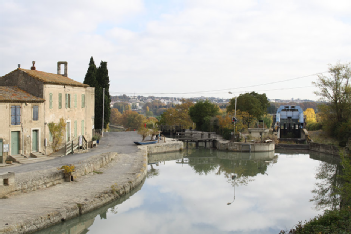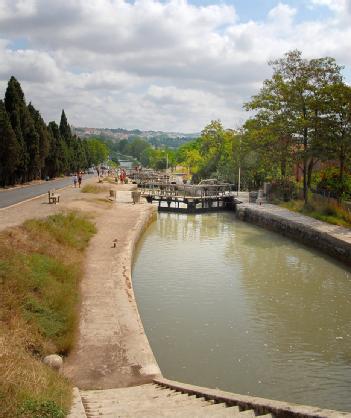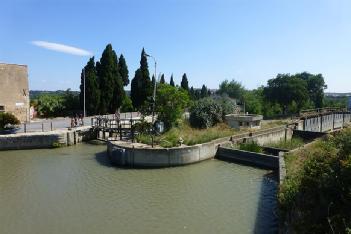
 |
Canal du Midi - Écluses et Pente d'eau de Fonseranes |
34500 Béziers, Francia (Occitanie) |
|
| Indirizzo |
Office de Tourisme Béziers Méditerranée - Neuf Ecluses de Fonseranes
Chemin des 9 Écluses |
| Spazio espositivo | - purtroppo ancora non noto |
Navy / Watercraft
- Cranes and Lifts
- Patrimonio dell'umanità
|
Orario d'apertura
|
|||||
|
Status dal 03/2023
|
We don't know the fees. Non conosciamo la tariffa. |
||||
| Contatti |
|
||||
| Pagina web |
www.canalmidi.com www.beziers-in-mediterranee.com/les-9-ecluses-de-fonseranes |
||||
| Come arrivare |
The Fonserannes Water Slope is a disused inclined plane on the Canal du Midi parallel to the Fonserannes Lock. |
| Descrizione | Wikipedia: They consist of eight ovoid-shaped lock chambers and nine gates, which allow boats to be raised a height of 21.5 m over a distance of 300 m. The flight was originally built as an 8-rise, which together with the ninth lock allowed boats to cross the Orb river on a level and re-enter the canal further downstream. The "nine locks" name dates from this time. However, in 1858 an aqueduct was built to replace the crossing of the Orb. Boats now enter and leave the lower end of the flight through the side of chamber seven, which is permanently kept at its upper water level. The flight is therefore effectively made up of six locks. The lower gates of the seventh chamber are now permanently closed; the eighth chamber and the ninth lock, the pre-1858 route descending to the Orb, are disused. This side exit from chamber seven causes some confusion in describing the flight of locks. While most sources now ignore the disused eighth chamber, some still describe the flight as a seven-rise, despite chamber seven being permanently at the lower canal level. In 1983 the Fonserannes inclined plane was built adjacent to the locks, to allow commercial traffic and boats too large for the locks to bypass them. Fonserannes Water Slope This technique for a water slope was described by the French engineer Jean Aubert in 1961. It was designed to lift vessels of up to 350 tonnes displacement. The slope, the second and last to be constructed in France, was built between 1980 and 1983 with the intent of replacing the seven locks at the Fonserannes Locks. Trial operations commenced in May 1984. However, within weeks a number of technical problems emerged as oil leaking from the hydraulic system lubricated the concrete tracks and the wheels on the lift were unable to gain sufficient traction to raise the chamber to the top of the slope. It took until 1986 to resolve the technical, contractual, and insurance issues. This problem was never satisfactorily resolved and the slope was abandoned officially on 11 April 2001. Operation The water slope uses a moveable gate in a sloping channel. To ascend the slope the moving gate can be opened to allow a boat to enter the concrete channel. The gate then closes off the bottom of the channel and seals off a wedge of water on which the boat is floating, within the channel. The moveable gate is drawn up the sloping concrete channel pushing the wedge of water before it until reaching the upper water level. When the water level in the wedge is equalised with that of the upper canal, an upper (non-moving) gate is opened and the boat is then allowed to float free. Descending the water slope is the reverse of the ascent. |
[dsp_museum_detail.cfm]
| Conformità dei dati | Ulteriori informazioni |
















